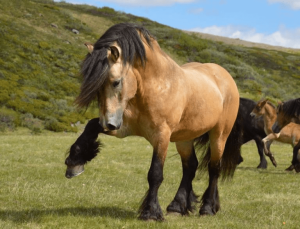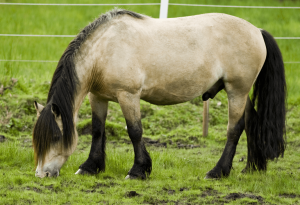The Dole Horse of Norway – An Excellent Blend of Strength and Elegance.
Nestled within the embrace of Norway’s Gudbrandsdal valley lies an enigmatic figure, carrying the weight of centuries on its sturdy shoulders – the Dole horse. As we embark on a journey through time, this equine companion unfolds a narrative rich in heritage, adaptation, and a steadfast resilience that echoes through the annals of Norway’s history.

Image credits: Matilde Brandt, Solveig Johanne Rasmussen Photography.
From the ancient whispers of Frisian hooves imprinting the valley soil to the orchestrated breeding efforts of the 19th century, the Dole horse emerges as a living chronicle. A breed known by various names – Dølehest, Dole Trotter, Dole Gudbrandsdal – it is not merely a horse; it is a custodian of cultural legacies.
In the aftermath of World War II, where the Dole Gudbrandsdal stood sentinel alongside German forces, and amidst the threat of industrialization, the Dole horse found its champions in the form of the National Dølehorse Association. This is not just a tale of survival; it’s a testament to a breed’s ability to thrive against the currents of change.
Beyond the pages of history, the Dole horse graces the modern landscape, contributing to agricultural endeavors, embracing the adrenaline-fueled world of harness racing, and embodying the enduring spirit of Norway’s equine heritage.
As we navigate through the distinctive traits that define the Dole – a small head, square muzzle, and powerful hindquarters – we unravel a story of intentional breeding, where form meets function in a harmonious dance.
Join us in this odyssey through the realms of the Dole horse, where echoes of a noble past reverberate through valleys, telling a tale of guardianship, resilience, and an indomitable connection between a breed and the land it calls home.

Originating in the picturesque Gudbrandsdal valley of Norway, the Dole horse stands as a testament to centuries of heritage and resilience. Believed to date back to 400-800 BC, the breed’s roots intertwine with the arrival of Frisians, trading their robust black horses and leaving an indelible mark on the Dole’s conformation.
The Dole, also known as Dølehest, Dole Trotter, Dole Gudbrandsdal, Ostlandhester, and Norwegian Trotter, evolved through organized breeding in the 19th century. Initially a versatile workhorse, the breed’s formalized breeding began with the establishment of the first studbook in 1841. The demands of harness racing in the 19th century led to the creation of two distinct types: the lighter, faster Dole Trotter, and the heavier, stronger Dole Gudbrandsdal.

The heavy Dole Gudbrandsdal gained prominence during World War II, utilized extensively by the Germans during their occupation of Norway. However, post-war industrialization saw a decline in the breed’s population as machinery replaced working draught horses. In response, the National Dølehorse Association emerged in 1967, dedicated to preserving and promoting the original Dole Gudbrandsdal.
The Dole presents the characteristics of a light draught horse – sturdy, muscular, and compact. Standing between 14.1 and 16 hands high, it is among the smaller draught breeds. Dole horses exhibit a variety of colors, with black, bay, chestnut, and brown being common. Noteworthy features include a thick, long mane and tail, a small head with a square muzzle, and a powerful build with a broad chest and muscular hindquarters.

While the Dole Trotter and Dole Gudbrandsdal studbooks were initially kept separate, increased interbreeding has blurred the lines, contributing to a genetic resurgence. Today, the breed boasts over 4,000 individuals worldwide, with careful breeding correcting conformational issues and reviving the original type. The Dole’s intelligence, elegance, calm disposition, hardiness, and stamina make it a cherished breed.
In a remarkable display of adaptability, many Dole horses are set loose in the mountain pastures, with mares often foaling in the rugged terrain. Protected by fierce stallions, these herds thrive in the face of natural predators, reflecting the breed’s robust nature.
In conclusion, the story of the Dole horse is one of triumph over challenges, a celebration of tradition, and an embrace of adaptability. As these horses continue to grace Norway’s landscapes, their hooves echo the resilience of a breed deeply rooted in history yet galloping towards a future where tradition and progress harmoniously coexist.
Also to read: The Icelandic Horse: An Island treasure in the world of equines




